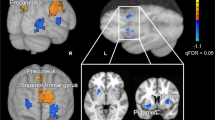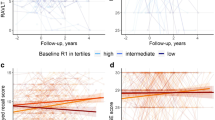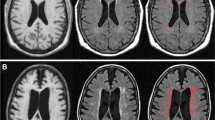Abstract
Purpose
This study was undertaken to explore the mechanisms underlying cognitive reserve in subjects with mild memory deficits by using positron emission tomography (PET).
Methods
Global cerebral blood flow (gCBF) and cerebrovascular reserve (CVR) measurements were performed in 15 elders (5 men, 10 women, 62–84, 71.8 ± 6.2 years) meeting criteria for mild cognitive impairment (MCI). PET consisted of quantitative [15O]water determinations of CBF, two at baseline and one postadministration of acetazolamide (ACZ).
Results
Mean gCBF were 44.9 ± 5.5 during counting, 44.5 ± 6.7 for the memory task, and 60.2 ± 4.8 ml/min/100 g for post-ACZ (CVR of 33.9 ± 13.2%). Task-related gCBF change was significantly related to memory score, performance on the Trail Making Test B (Trails-B), premorbid IQ, and education, and differed significantly between the learning-based groups.
Conclusions
Cognitive reserve appears analogous to cardiac reserve. The ability to alter gCBF paralleled performance on general cognitive measures, was enhanced in higher levels of cognitive reserve, and was impaired in individuals who no longer appear to benefit from repeated exposure to testing.


Similar content being viewed by others
References
Anonymous (1974) Dorland’s illustrated medical dictionary, 25th edn. Philadelphia, PA: W.B. Saunders
Stern Y, Gurland B, Tatemichi TK, Tang MX, Wilder D, Mayeux R (1994) Influence of education and occupation on the incidence of Alzheimer’s disease. J Am Med Assoc 271(13):1004–1010
Alexander GE, Furey ML, Grady CL, et al. (1997) Association of premorbid intellectual function with cerebral metabolism in Alzheimer’s disease: implications for the cognitive reserve hypothesis. Am J Psychiatry 154:165–172
Scarmeas N, Levy G, Tang MX, Manly J, Stern Y (2001) Influence of leisure activity on the incidence of Alzheimer’s disease. Neurology 57(12):2236–2242
Scarmeas N, Stern Y (2003) Cognitive reserve and lifestyle. J Clin Exp Neuropsychol 25(5):625–633
Scarmeas N, Zarahn E, Anderson KE, et al. (2003) Association of life activities with cerebral blood flow in Alzheimer disease: implications for the cognitive reserve hypothesis. Arch Neurol 60(3):359–365
Wilson RS, Mendes de Leon CF, Barnes LL, et al. (2002) Participation in cognitively stimulating activities and risk of incident Alzheimer disease. JAMA 287(6):742–748
Stern Y, Albert S, Tang MX, Tsai WY (1999) Rate of memory decline in AD is related to education and occupation: cognitive reserve? Neurology 53:1942–1947
Stern Y, Alexander GE, Prohovnik I, Mayeux R (1992) Inverse relationship between education and parietotemporal perfusion deficit in Alzheimer’s disease. Ann Neurol 32:371–375
Stern Y, Alexander GE, Prohovnik I, et al. (1995) Relationship between lifetime occupation and parietal flow: implications for a reserve against Alzheimer’s disease pathology. Neurology 45:55–60
Scarmeas N, Zarahn E, Anderson KE, et al. (2003) Cognitive reserve modulates functional brain responses during memory tasks: a PET study in healthy young and elderly subjects. NeuroImage 19(3):1215–1227
Scarmeas N, Zarahn E, Anderson KE, et al. (2004) Cognitive reserve-mediated modulation of positron emission tomographic activations during memory tasks in Alzheimer disease. Arch Neurol 61(1):73–78
Stern Y (2002) What is cognitive reserve? Theory and research application of the research concept. J Int Neuropsychol Soc 8(3):448–460
Pietrini P, Furey ML, Alexander GE, et al. (1999) Association between brain functional failure and dementia severity in Alzheimer’s disease: resting versus stimulation PET study. Am J Psychiatry 156(3):470–473
Pietrini P, Alexander GE, Furey ML, et al. (2000) Cerebral metabolic response to passive audiovisual stimulation in patients with Alzheimer’s disease and healthy volunteers assessed by PET. J Nucl Med 41(4):575–583
Nagata K, Buchan RJ, Yokoyama E, et al. (1997) Misery perfusion with preserved vascular reactivity in Alzheimer’s disease. Ann NY Acad Sci 826(1):272–281
Pavics L, Grunwald F, Reichmann K, et al. (1999) Regional cerebral blood flow single-photon emission tomography with 99mTc-HMPAO and the acetazolamide test in the evaluation of vascular and Alzheimer’s dementia. Eur J Nucl Med Mol Imaging 26(3):239–245
Barona A, Reynolds CR, Chastain R (1984) A demographically based index of premorbid intelligence for the WAIS-R. J Consult Clin Psychol 52(5):885–887
Petersen RC, Smith GE, Waring SC, Ivnik RJ, Tangalos EG, Kokmen E (1999) Mild cognitive impairment: clinical characterization and outcome. Arch Neurol 56(3):303–308
Mattis S (1988) Dementia Rating Scale (DRS). Odessa, FL: Psychological Assessment Resources, Incorporated
Lucas JA, Ivnik RJ, Smith GE, et al. (1998) Normative data for the Mattis Dementia Rating Scale. J Clin Exp Neuropsychol 20(4):536–547
Benedict RHB (1997) Brief visuospatial memory test-revised. Odessa, FL: Psychological Assessment Resources, Incorporated
Wechsler D (1997) Wechsler Adult Intelligence Scale-III (WAIS-III). San Antonio, TX: Psychological Corporation
Folstein M, Folstein S, McHugh P (1975) Mini-mental state: a practical method for grading the cognitive state of patients for the clinician. J Psychiatr Res 12:189–198
Benedict RHB, Schretlen D, Groninger L, et al. (1998) Hopkins verbal learning test-revised: normative data and analysis of inter-form and test–retest reliability. Clin Neuropsychol 12:43–55
Duff K, Beglinger LJ, Moser DJ, Ponto LLB, Ekstam-Smith K, Schultz SK (2004) Practice effects in older adults with mild cognitive impairments: preliminary support for two courses (abstract). Arch Clin Neuropsychol 19(7):980
Lezak MD (1995) Neuropsychological assessment. New York: Oxford University Press
Hurtig RR, Hichwa RD, O’Leary DS, et al. (1994) Effects of timing and duration of cognitive activation in [15O]water PET studies. J Cereb Blood Metab 14:423–430
Hichwa RD, Ponto LLB, Watkins GL (1995) Clinical blood flow measurements with [15-O]water and positron emission tomography. In: Emran AM (ed) Chemists’ views of imaging centers. New York: Plenum Press, pp 401–417
Wollenweber SD, Hichwa RD, Ponto LLB (1997) A simple on-line arterial time–activity curve detector for [O-15] water PET studies. IEEE Trans Nucl Sci 44(4):1613–1617
Ponto LLB, Schultz SK, Leonard Watkins G, Hichwa RD (2004) Technical issues in the determination of cerebrovascular reserve in elderly subjects using 15O-water PET imaging. NeuroImage 21(1):201–210
Andreasen NC, O’Leary DS, Cizadlo T, et al. (1995) II. PET studies of memory: novel versus practiced free recall of word lists. NeuroImage 2:296–305
Ponto LLB, Watkins GL, Hichwa RD, et al. (2002) [15O]Water pharmacokinetics: influence of age and gender in normal subjects. Mol Imaging Biol 4(2):129–137
Stern Y, Zarahn E, Hilton HJ, Flynn J, DeLaPaz R, Rakitin B (2003) Exploring the neural basis of cognitive reserve. J Clin Exp Neuropsychol 25(5):691–701
Habeck C, Hilton HJ, Zarahn E, Flynn J, Moeller J, Stern Y (2003) Relation of cognitive reserve and task performance to expression of regional covariance networks in an event-related fMRI study of nonverbal memory. NeuroImage 20(3):1723–1733
Stern Y, Habeck C, Moeller J, et al. (2005) Brain networks associated with cognitive reserve in healthy young and old adults. Cereb Cortex 15(4):394–402
Nyberg L, Sandblom J, Jones S, et al. (2003) Neural correlates of training-related memory improvement in adulthood and aging. PNAS 100(23):13728–13733
Acknowledgments
This study was made possible by Grant number NIH 1 R21 MH61801-01A1. The authors acknowledge the efforts of Karen Ekstam-Smith and Jane Kerr for subject recruitment, study scheduling and coordination, and neuropsychological testing; Jo Clark, Amy Conklin, and Lea Weldon for arterial catheter placement and blood sampling; Kathy Thede-Reynolds and Len Watkins for [15O]water quality assurance testing; Dean Clermont, Christine Mundt, Beth Schmitt, Julie Riggert, and John Richmond for PET data acquisition and processing; Xiying Chen for MRI and PET coregistration; and Dr. Joan Maley for assessment of MRI for structural pathology.
Author information
Authors and Affiliations
Corresponding author
Rights and permissions
About this article
Cite this article
Boles Ponto, L.L., Magnotta, V.A., Moser, D.J. et al. Global Cerebral Blood Flow in Relation to Cognitive Performance and Reserve in Subjects with Mild Memory Deficits. Mol Imaging Biol 8, 363–372 (2006). https://doi.org/10.1007/s11307-006-0066-z
Published:
Issue Date:
DOI: https://doi.org/10.1007/s11307-006-0066-z




